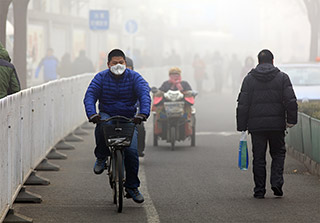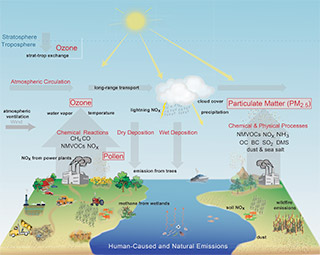Climate Change and Human Health

Climate change affects air quality, which in turn can lead to adverse health outcomes. Disruptions to weather patterns influence our air quality by increasing and distributing air pollutants, such as ground-level ozone, fine particulates, wildfire smoke, and dust. Changes to weather seasons also impact the production, distribution, and severity of airborne allergens. The EPA’s Air Quality National Summary Report states that around 100 million people living in the U.S. reside in communities where air pollution exceeds health-based air quality standards1 . While primarily affecting outdoor air quality, these pollutants and allergens can also impair indoor air quality by entering homes, schools, and buildings. Additionally, climate change may contribute to the increased prevalence of indoor pollutants like mold.
Respiratory and Cardiovascular Impacts
Poor air quality can negatively affect human health. Exposure to air pollutants or airborne allergens can directly harm our respiratory and cardiovascular systems or exacerbate existing conditions in susceptible populations2 , 3 , 4 . Children, older adults, persons with asthma, and immunocompromised persons are most vulnerable to air quality impacts.

Respiratory impacts can include asthma, respiratory allergies, and airway diseases5 , while cardiovascular impacts can include hypertension, coronary artery disease, heart attack, and stroke6 . Globally, millions of premature deaths are caused by air pollution7 . Exposure to and inhalation of ground-level ozone and particulate pollution account for tens of thousands of hospital visits each year8 . Symptoms of ozone and particulate pollution exposure can include chest pain, coughing, throat irritation, congestion, and reduced lung function. Similarly, higher pollen concentrations and longer growing seasons, consequences of warming temperatures, can increase sensitivity to allergens and severe allergic reactions, such as allergy-induced asthma attacks.
Climate-related changes to weather patterns are increasing the frequency and severity of droughts9 , which can create conditions for dust and dust-borne pathogens such as bacterial and fungal spores to enter homes, buildings, and schools.
Opportunities for Public Health Improvement
Changes to the built environment can be effective measures to protect human health and safeguard communities from the health effects of climate change. For example, low impact landscaping and tree cover in urban settings can help mitigate air pollution.
Effective measures for improving air quality can also include transportation alternatives. Reducing the number of vehicle miles traveled while increasing carpooling, use of public transportation, and other alternative transportation options can lower the level of emissions of ozone, particulate matter, and other pollutants associated with respiratory and cardiovascular diseases. Reduced electricity use in areas that burn coal or other fossil fuels for energy production can lower exposure to heavy metals, such as mercury and lead, and nitrogen oxides and sulfur oxides.
Research Needs
Research and research translation are important to further understand the effects of climate change and air quality impacts. Air quality impacts depend on complex synergistic effects of temperature, weather variability, long-term climate change, and environmental exposures. Transdisciplinary approaches to research in this field is critical.
Air quality monitoring to evaluate pollution, air-borne allergens, aerosolized pathogens, and dust burdens will improve the ability to model future health impacts. In addition, data collection on climate-dependent variables, such as wildfires and land-use, will improve understanding of their impacts on health.
Research is also needed to better understand climate impacts on indoor air quality, including temperature, humidity, ventilation, fungi, mold, biological contaminants, and volatile organic compounds.
-
Air Quality - National Summary. EPA creates air quality trends using measurements from monitors located across the country. The table below show that air quality based on concentrations of the common pollutants has improved nationally since 1980. [Full Text Air Quality - National Summary. EPA creates air quality trends using measurements from monitors located across the country. The table below show that air quality based on concentrations of the common pollutants has improved nationally since 1980.]
-
Sacks, J. D., L. W. Stanek, T. J. Luben, D. O. Johns, B. J. Buckley, J. S. Brown, and M. Ross, 2011: Particulate matter–induced health effects: Who is susceptible? Environmental Health Perspectives, 119 (4), 446–454. [Abstract Sacks, J. D., L. W. Stanek, T. J. Luben, D. O. Johns, B. J. Buckley, J. S. Brown, and M. Ross, 2011: Particulate matter–induced health effects: Who is susceptible? Environmental Health Perspectives, 119 (4), 446–454.] [Full Text Sacks, J. D., L. W. Stanek, T. J. Luben, D. O. Johns, B. J. Buckley, J. S. Brown, and M. Ross, 2011: Particulate matter–induced health effects: Who is susceptible? Environmental Health Perspectives, 119 (4), 446–454.]
-
Lee, Byeong-Jae et al. Air pollution exposure and cardiovascular disease. Toxicological Research vol. 30,2 (2014): 71-5. doi:10.5487/TR.2014.30.2.071. [Abstract Lee, Byeong-Jae et al. Air pollution exposure and cardiovascular disease. Toxicological Research vol. 30,2 (2014): 71-5. doi:10.5487/TR.2014.30.2.071.]
-
Jiang, Xu-Qin et al. Air pollution and chronic airway diseases: what should people know and do?. Journal of Thoracic Disease vol. 8,1 (2016): E31-40. doi:10.3978/j.issn.2072-1439.2015.11.50. [Abstract Jiang, Xu-Qin et al. Air pollution and chronic airway diseases: what should people know and do?. Journal of Thoracic Disease vol. 8,1 (2016): E31-40. doi:10.3978/j.issn.2072-1439.2015.11.50.]
-
Jiang, Xu-Qin et al. Air pollution and chronic airway diseases: what should people know and do?. Journal of Thoracic Disease vol. 8,1 (2016): E31-40. doi:10.3978/j.issn.2072-1439.2015.11.50. [Abstract Jiang, Xu-Qin et al. Air pollution and chronic airway diseases: what should people know and do?. Journal of Thoracic Disease vol. 8,1 (2016): E31-40. doi:10.3978/j.issn.2072-1439.2015.11.50.]
-
Lee, Byeong-Jae et al. Air pollution exposure and cardiovascular disease. Toxicological Research vol. 30,2 (2014): 71-5. doi:10.5487/TR.2014.30.2.071. [Abstract Lee, Byeong-Jae et al. Air pollution exposure and cardiovascular disease. Toxicological Research vol. 30,2 (2014): 71-5. doi:10.5487/TR.2014.30.2.071.]
-
Air pollution is contamination of the indoor or outdoor environment by any chemical, physical or biological agent that modifies the natural characteristics of the atmosphere. Household combustion devices, motor vehicles, industrial facilities and forest fires are common sources of air pollution. Pollutants of major public health concern include particulate matter, carbon monoxide, ozone, nitrogen dioxide and sulfur dioxide. Outdoor and indoor air pollution cause respiratory and other diseases and is an important source of morbidity and mortality. [Full Text Air pollution is contamination of the indoor or outdoor environment by any chemical, physical or biological agent that modifies the natural characteristics of the atmosphere. Household combustion devices, motor vehicles, industrial facilities and forest fires are common sources of air pollution. Pollutants of major public health concern include particulate matter, carbon monoxide, ozone, nitrogen dioxide and sulfur dioxide. Outdoor and indoor air pollution cause respiratory and other diseases and is an important source of morbidity and mortality.]
-
Zhang, Junfeng Jim et al. Ozone Pollution: A Major Health Hazard Worldwide. Frontiers in immunology vol. 10 2518. 31 Oct. 2019, doi:10.3389/fimmu.2019.02518. [Abstract Zhang, Junfeng Jim et al. Ozone Pollution: A Major Health Hazard Worldwide. Frontiers in immunology vol. 10 2518. 31 Oct. 2019, doi:10.3389/fimmu.2019.02518.]
-
IPCC, 2021: Climate Change 2021: The Physical Science Basis. Contribution of Working Group I to the Sixth Assessment Report of the Intergovernmental Panel on Climate Change [Masson-Delmotte, V., P. Zhai, A. Pirani, S.L. Connors, C. Péan, S. Berger, N. Caud, Y. Chen, L. Goldfarb, M.I. Gomis, M. Huang, K. Leitzell, E. Lonnoy, J.B.R. Matthews, T.K. Maycock, T. Waterfield, O. Yelekçi, R. Yu, and B. Zhou (eds.)]. Cambridge University Press. In Press. [Full Text IPCC, 2021: Climate Change 2021: The Physical Science Basis. Contribution of Working Group I to the Sixth Assessment Report of the Intergovernmental Panel on Climate Change [Masson-Delmotte, V., P. Zhai, A. Pirani, S.L. Connors, C. Péan, S. Berger, N. Caud, Y. Chen, L. Goldfarb, M.I. Gomis, M. Huang, K. Leitzell, E. Lonnoy, J.B.R. Matthews, T.K. Maycock, T. Waterfield, O. Yelekçi, R. Yu, and B. Zhou (eds.)]. Cambridge University Press. In Press.]
-
Air Quality - National Summary. EPA creates air quality trends using measurements from monitors located across the country. The table below show that air quality based on concentrations of the common pollutants has improved nationally since 1980. [Full Text Air Quality - National Summary. EPA creates air quality trends using measurements from monitors located across the country. The table below show that air quality based on concentrations of the common pollutants has improved nationally since 1980.]
-
Sacks, J. D., L. W. Stanek, T. J. Luben, D. O. Johns, B. J. Buckley, J. S. Brown, and M. Ross, 2011: Particulate matterâinduced health effects: Who is susceptible? Environmental Health Perspectives, 119 (4), 446â454. [Abstract Sacks, J. D., L. W. Stanek, T. J. Luben, D. O. Johns, B. J. Buckley, J. S. Brown, and M. Ross, 2011: Particulate matterâinduced health effects: Who is susceptible? Environmental Health Perspectives, 119 (4), 446â454.] [Full Text Sacks, J. D., L. W. Stanek, T. J. Luben, D. O. Johns, B. J. Buckley, J. S. Brown, and M. Ross, 2011: Particulate matterâinduced health effects: Who is susceptible? Environmental Health Perspectives, 119 (4), 446â454.]
-
Lee, Byeong-Jae et al. Air pollution exposure and cardiovascular disease. Toxicological Research vol. 30,2 (2014): 71-5. doi:10.5487/TR.2014.30.2.071. [Abstract Lee, Byeong-Jae et al. Air pollution exposure and cardiovascular disease. Toxicological Research vol. 30,2 (2014): 71-5. doi:10.5487/TR.2014.30.2.071.]
-
Jiang, Xu-Qin et al. Air pollution and chronic airway diseases: what should people know and do?. Journal of Thoracic Disease vol. 8,1 (2016): E31-40. doi:10.3978/j.issn.2072-1439.2015.11.50. [Abstract Jiang, Xu-Qin et al. Air pollution and chronic airway diseases: what should people know and do?. Journal of Thoracic Disease vol. 8,1 (2016): E31-40. doi:10.3978/j.issn.2072-1439.2015.11.50.]
-
Jiang, Xu-Qin et al. Air pollution and chronic airway diseases: what should people know and do?. Journal of Thoracic Disease vol. 8,1 (2016): E31-40. doi:10.3978/j.issn.2072-1439.2015.11.50. [Abstract Jiang, Xu-Qin et al. Air pollution and chronic airway diseases: what should people know and do?. Journal of Thoracic Disease vol. 8,1 (2016): E31-40. doi:10.3978/j.issn.2072-1439.2015.11.50.]
-
Lee, Byeong-Jae et al. Air pollution exposure and cardiovascular disease. Toxicological Research vol. 30,2 (2014): 71-5. doi:10.5487/TR.2014.30.2.071. [Abstract Lee, Byeong-Jae et al. Air pollution exposure and cardiovascular disease. Toxicological Research vol. 30,2 (2014): 71-5. doi:10.5487/TR.2014.30.2.071.]
-
Air pollution is contamination of the indoor or outdoor environment by any chemical, physical or biological agent that modifies the natural characteristics of the atmosphere. Household combustion devices, motor vehicles, industrial facilities and forest fires are common sources of air pollution. Pollutants of major public health concern include particulate matter, carbon monoxide, ozone, nitrogen dioxide and sulfur dioxide. Outdoor and indoor air pollution cause respiratory and other diseases and is an important source of morbidity and mortality. [Full Text Air pollution is contamination of the indoor or outdoor environment by any chemical, physical or biological agent that modifies the natural characteristics of the atmosphere. Household combustion devices, motor vehicles, industrial facilities and forest fires are common sources of air pollution. Pollutants of major public health concern include particulate matter, carbon monoxide, ozone, nitrogen dioxide and sulfur dioxide. Outdoor and indoor air pollution cause respiratory and other diseases and is an important source of morbidity and mortality.]
-
Zhang, Junfeng Jim et al. Ozone Pollution: A Major Health Hazard Worldwide. Frontiers in immunology vol. 10 2518. 31 Oct. 2019, doi:10.3389/fimmu.2019.02518. [Abstract Zhang, Junfeng Jim et al. Ozone Pollution: A Major Health Hazard Worldwide. Frontiers in immunology vol. 10 2518. 31 Oct. 2019, doi:10.3389/fimmu.2019.02518.]
-
IPCC, 2021: Climate Change 2021: The Physical Science Basis. Contribution of Working Group I to the Sixth Assessment Report of the Intergovernmental Panel on Climate Change [Masson-Delmotte, V., P. Zhai, A. Pirani, S.L. Connors, C. Péan, S. Berger, N. Caud, Y. Chen, L. Goldfarb, M.I. Gomis, M. Huang, K. Leitzell, E. Lonnoy, J.B.R. Matthews, T.K. Maycock, T. Waterfield, O. Yelekçi, R. Yu, and B. Zhou (eds.)]. Cambridge University Press. In Press. [Full Text IPCC, 2021: Climate Change 2021: The Physical Science Basis. Contribution of Working Group I to the Sixth Assessment Report of the Intergovernmental Panel on Climate Change [Masson-Delmotte, V., P. Zhai, A. Pirani, S.L. Connors, C. Péan, S. Berger, N. Caud, Y. Chen, L. Goldfarb, M.I. Gomis, M. Huang, K. Leitzell, E. Lonnoy, J.B.R. Matthews, T.K. Maycock, T. Waterfield, O. Yelekçi, R. Yu, and B. Zhou (eds.)]. Cambridge University Press. In Press.]


